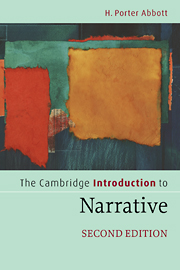Book contents
- Frontmatter
- Contents
- List of illustrations
- Preface
- Preface to the second edition
- Acknowledgments
- Chapter 1 Narrative and life
- Chapter 2 Defining narrative
- Chapter 3 The borders of narrative
- Chapter 4 The rhetoric of narrative
- Chapter 5 Closure
- Chapter 6 Narration
- Chapter 7 Interpreting narrative
- Chapter 8 Three ways to interpret narrative
- Chapter 9 Adaptation across media
- Chapter 10 Character and self in narrative
- Chapter 11 Narrative and truth
- Chapter 12 Narrative worlds
- Chapter 13 Narrative contestation
- Chapter 14 Narrative negotiation
- Notes
- Bibliography
- Glossary and topical index
- Index of authors and narratives
Chapter 3 - The borders of narrative
- Frontmatter
- Contents
- List of illustrations
- Preface
- Preface to the second edition
- Acknowledgments
- Chapter 1 Narrative and life
- Chapter 2 Defining narrative
- Chapter 3 The borders of narrative
- Chapter 4 The rhetoric of narrative
- Chapter 5 Closure
- Chapter 6 Narration
- Chapter 7 Interpreting narrative
- Chapter 8 Three ways to interpret narrative
- Chapter 9 Adaptation across media
- Chapter 10 Character and self in narrative
- Chapter 11 Narrative and truth
- Chapter 12 Narrative worlds
- Chapter 13 Narrative contestation
- Chapter 14 Narrative negotiation
- Notes
- Bibliography
- Glossary and topical index
- Index of authors and narratives
Summary
Framing narratives
As you move to the outer edges of a narrative, you may find that it is embedded in another narrative. The containing narrative is what is called a framing narrative. Classic examples of framing narratives, or frame-tales, are Boccaccio's Decameron (1351–3), Chaucer's Canterbury Tales (1387–1400), and the Thousand and One Nights (c. 1450), in which an embracing narrative acts as a framework within which a multitude of tales are told. In the Thousand and One Nights, for example, the sultan Schahriah, in his bitterness against women, resolves to marry a new woman every day and to strangle her each morning before sunrise to ensure that she will never be unfaithful to him. Scheherazade marries him anyway but escapes execution through the strategy of telling the sultan a story every night and breaking off just before the climax each morning at sunrise. The sultan is hooked, and Scheherazade winds up telling a thousand and one stories. This framing narrative has its own conclusion, which I won't give away here, but it also works as a way of collecting together a multitude of quite different stories.
There are numerous examples of framing narratives that are much more modest than these in that they only frame a single narrative, either a short story, or a novel, or a film, or whatever. Yet such framing narratives can play critically important roles in the interpretation of the narratives they frame.
- Type
- Chapter
- Information
- The Cambridge Introduction to Narrative , pp. 28 - 39Publisher: Cambridge University PressPrint publication year: 2008



